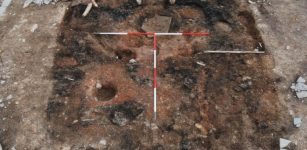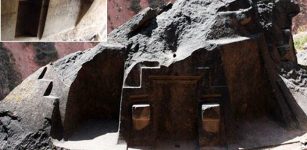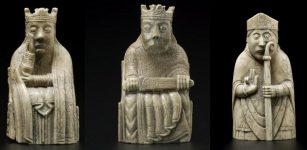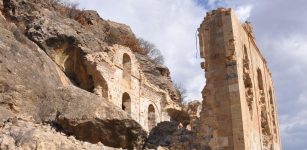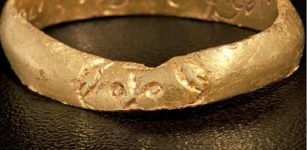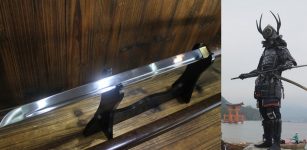Still Intact 460-Year-Old Bow Found Underwater In Alaska Baffles Scientists – Where Did It Come From?
Jan Bartek - AncientPages.com - Archaeologists are baffled because they cannot explain how this bow ended up underwater in Alaska. Where did it come from? Who used it? These are some of the questions that need answers.
The well-crafted wooden hunting bow measures 54 inches from tip to tip and is in a good state of preservation. It was found by National Park Service employees in the waters of an inland lake inside Lake Clark National Park and Preserve.
NPS archaeologist Jason Rogers and Alaska State archaeologist Rich VanderHoek inspect the bow. Credit: NPS
“Following the discovery, the bow was transported to the National Park Service’s Alaska Regional Curatorial Center in Anchorage, where it is currently undergoing analysis and conservation treatment.
Archeologists submitted a small sample of the bow for radiocarbon dating analysis in early March 2022. The results indicate that the bow is approximately 460 years old with a date range between AD 1506 and AD 1660,” the National Park Service informs.
However, the real mystery lies not in how old the bow is, but where it came from.
“Park officials found the antique weapon on Dena’ina lands, an Athabascan indigenous people whose ancestral lands cover much of South-Central Alaska, including a large portion of Lake Clark National Park and Preserve. However, preliminary research suggests that the handcrafted bow might not be of Dena’ina origin,” the Outdoor Life reports. The National Park Services consulted with Elders and research this discovery by comparing the bow with similar artifacts held in museums in Alaska and beyond.
Preliminary research suggests the bow is most likely made of spruce and may represent a Yup’ik or Alutiiq style bow, more commonly made in Western Alaska or on the Alaska Peninsula than in the Lake Clark region.
“While Lake Clark National Park is primarily the ancestral homeland of the Dena’ina people for thousands of years, Yup’ik speaking people have resided nearby, along the southern and western shores of Lake Iliamna. For the Dena’ina people, trading and sharing knowledge with their Yup’ik neighbors as well as other groups such as the Tanana, Tlingit, Ahtna, Deg Hit’an and coastal residents of Prince William Sound and Kodiak was common,” the NPS informs.
Lake Clark National Park and Preserve is located on Dena’ina lands in south-central Alaska. Credit: NPS
As Outdoor Life explains, “The homeland of the Dena’ina, which comprises roughly 41,000 square miles along the coast of the Cook Inlet, is called the Denaʼina Ełnena, and it includes lands where present-day Anchorage is located. Dena’ina lands also cover much of Lake Clark National Park and Preserve, including the lake itself, which is traditionally known as “Qizhjeh Vena”.
The Dena’ina culture, which prioritizes a connection to nature and respect for the wilderness, has a rich history in the Athabascan region. “We call this ‘K’etniyi’ meaning ‘it’s saying something,” writes Karen Evanhoff, cultural anthropologist for Lake Clark National Park and Preserve.”
“'My Chuda Alexie (Evan) said that when they would get the material for building the bow, they would go to the mountains. The trees (spruce) up there are a lot stronger because of the wind. The wind blowing the trees makes them bend, so that makes the wood stronger. They used to tell stories about hunting with bow and arrows and times when they used them for wars,” Dena’ina expert George Alexie recalls his grandfather talking about the wood used to make bows.
Dr. Priscilla Morris examines the bow with a hand lens. Credit: NPS
Compression wood, which is the wood from the underside curve of a coniferous tree like a spruce growing in a slanted position, has long been a favorite for making bows across many northern cultures, from Greenland to Alaska to Scandinavia.
“After inspecting the artifact, I am leaning towards spruce. Using the hand lens there were certain anatomic characteristics that lead me to believe spruce is the most likely species. There is presence of sap along with a multitude of small knots. Birch is also a suspected species, but I did not see any anatomical characteristics that lead me to believe birch over spruce,” said Dr. Priscilla Morris, Wood Biomass and Utilization Coordinator after inspecting the artifact.
See also: More Archaeology News
“Morris explained that her hypothesis was based solely on what she could see underneath a hand lens, and that a concrete identification would require looking at a cut-up sample underneath a microscope. This is unlikely to happen anytime soon, however, as the NPS wants to preserve the bow and keep it intact for the time being, “ the Outdoor Life informs.
According to NPS archaeologist Jason Rogers archaeological discoveries like this bow are rare in Alaska. “In Alaska, we just don’t have that kind of development so it’s very rare,” Rogers told the local news earlier this week. “It’s very rare for us to come across material like this.”
Written by Jan Bartek - AncientPages.com Staff Writer




